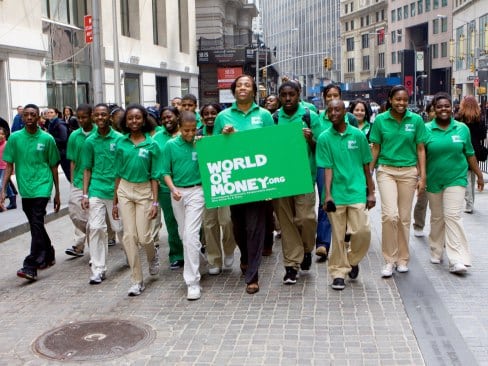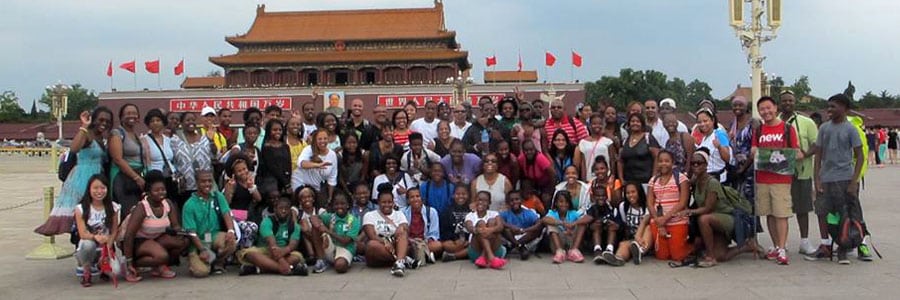 WorldofMoney.org is recognized as one of “top social good organizations in America,” and they take financial education seriously. Nice, but not uniquely interesting until you get a closer look at how they do it, with a model that hinges on measurable accountability from all constituents: youth, parents, partners. With respect to nonprofit decision-making, our theme for this month, Sabrina Lamb, Founder & CEO as well as author (“Do I look Like An ATM?), has navigated organizational turning points and critical decisions with a “skin in the game” approach that starts with the youth. The result is a move forward from beneficiary feedback into a form of beneficiary involvement that generates higher quality information to manage the organization and develop the curriculum. Markets For Good interviewed Sabrina for this dispatch.
WorldofMoney.org is recognized as one of “top social good organizations in America,” and they take financial education seriously. Nice, but not uniquely interesting until you get a closer look at how they do it, with a model that hinges on measurable accountability from all constituents: youth, parents, partners. With respect to nonprofit decision-making, our theme for this month, Sabrina Lamb, Founder & CEO as well as author (“Do I look Like An ATM?), has navigated organizational turning points and critical decisions with a “skin in the game” approach that starts with the youth. The result is a move forward from beneficiary feedback into a form of beneficiary involvement that generates higher quality information to manage the organization and develop the curriculum. Markets For Good interviewed Sabrina for this dispatch.
…
125 students have just graduated from the 8th class of the World of Money Youth Financial Education Institute. 89 of them and their parents have just returned from a trip to China. During the trip, an observer asked, “This is great! Who sponsored them?”
A nearly bewildered look followed Sabrina’s reply: “They did it themselves.”
The students take great pride in putting their knowledge to use and paying their own way. None are wealthy, coming from classically underserved populations. But, the word “underserved” breaks convention in this group. WorldofMoney.org describes as “underserved” anyone who does not have a working knowledge of money.
The curriculum includes basic Mandarin Chinese, Excel, community service, web programming, a Youth Business School, and year round follow-up alumni activities, among other components. Their results include 7-year olds able walk you from personal finance to hedge funds and a sustained trend of graduating 100+ students a year from a rigorous certification program, the alumni corps now totaling over 2500.

The “Aha!” Decision: Start Charging
“We treat the youth with the same respect and accountability that we treat the accomplished Wall Street professionals who deliver the curriculum.” This is a core ethic that grew out of a turning-point experience at the outset of the program in 2006.
While the early years of the program saw what many would deem success: educated students, a trip to Washington D.C. revealed a glaring gap in the program.
Sabrina Lamb: “When I founded the program, I approached it with the typical nonprofit intentions of “It’s free,” and “I’m here to help.” The response? A disturbing mix of “apathy” and “Kick Rocks!” from enough participants and parents to cause me to worry. One year we sponsored a family of three children and two parents for a trip to Washington D.C. They were effusive over how great an experience that they were having. When they attended the orientation however, and the parents and youth stood in line to receive their trip items, it pained me to see the family, who unbeknownst to anyone, had not paid, cowered in the corner as if they believed that they had not contributed to this experience. I vowed to never let anyone feel that way again. Everyone should feel that their contributions are valuable. That experience reinforced for me that good intentions must be paved with goals. When experiences are freely given the recipient does not feel invested.”
That incident led Sabrina to a change the way the mission was carried out. She made the participants an active part of the operating budget, requiring investment by the youth to pay their own tuition. As a result, she noticed a much higher level of students’ personal commitment to their own outcomes and richer feedback on program design from parents and instructors.
Finding The “Skin In The Game” Point
Sabrina is careful to point out that charging the students for the program is a principle, not a blueprint. It may not work for you. However, she notes that, “It’s possible to miss the underlying resentment or shame that simply giving things away can generate,” citing as a mantra, “We value your power to participate.” For World of Money, that means putting your own money to work for you on education that will show a long-term returns. Students who are not able to contribute funds at one point or another work as Classroom Leaders who also drive the organization. Everybody has something to contribute.
Sabrina credits finding that “skin in the game” point for generating a different type of conversation. “You can approach partners with a market-based conversation based on results, not with your hand out. And the students see themselves as having earned a seat at the table, both within the organization and in conversations with the world’s top financial professionals. They know that, ‘If you’re not at the table, you’re on the menu.’”
17-year old Asia Harvey Wright: “This program is appropriately called World of Money, because it truly feels like there is another world of information out there that most kids our age are never exposed to. Bills and paychecks and mutual funds are all deemed “grown folks business”, and we are left completely in the dark about everything. I think that if every parent would let their kids know about money awareness, the same way it is important to look both ways before you cross the street and never talk to (or take candy from) strangers. Maybe it’s not quite the same thing, but it’s still very important.”
Funding The Enterprise
Beyond the “Aha!” moment, the organization, approaching its tenth anniversary in 2015, World of Money continues to directly involve youth, the parents council, young professionals and partners as a base input to organizational decisions. As for partners, their role sends us to a recurring theme on Markets For Good: funding for organizational capacity. They have to pay instructors, secure space, train staff, etc. While students do fund their tuition and activities, their contribution does note equal the value of the attending the Institute; $2000.00 per student, and is only part of what sustains the organization. The organization welcomes qualified partners to participate in furthering the mission.
“We wouldn’t imagine funding a university by only funding student scholarships. Nonprofits should be seen the same way: It’s important to find partners willing to strengthen the whole enterprise.”
On that note, Sabrina Lamb seeks to partner with insightful and connected people who not only offer resources and knowledge, but who also embrace the urgency of youth financial education and are passionate about “truly transforming the lives of youth and their descendants, not just writing checks.”
…
